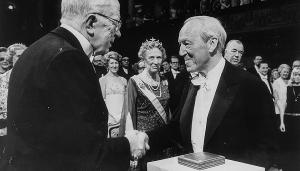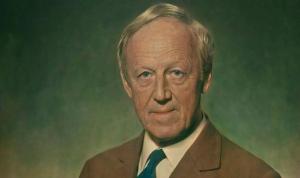Who was Hannes Alfvén?
If you are a plasma physicist, you certainly know all about Hannes Alfvén (äl′vān / pronounced AL-vee-en) already—but what about the rest of us? And why does his name keep cropping up in association with ITER?
Alfvén played a central role in the development of plasma physics and charged particle beams, and areas of technology benefitting from his contributions include controlled thermonuclear fusion, particle accelerators, hypersonic flight and rocket propulsion. He earned 15 major awards, and was one of only a handful of scientists who was a foreign member of both the United States and Soviet Academies of Sciences. He was also an accomplished linguist, speaking Swedish, English, German, French and Russian—as well as some Spanish and Chinese.
Alfvén is known for Alfvén Waves, the Alfvén Speed, the Alfvén—Klein model, and Alfven's theorem—and asteroid 1778 Alfvén is named after him. As if that's not enough, there's also the Hannes Alfvén Prize, awarded annually by the European Physical Society (EPS) for "outstanding contributions in plasma physics" and a Hannes Alfvén Medal, awarded for "outstanding scientific contributions towards the understanding of plasma processes in the solar system."
Hannes Olof Gösta Alfvén was born in Sweden in 1908. His parents were both practicing physicians—and his mother was one of the first female doctors to qualify in Sweden.
As a schoolboy, he was fascinated by Camille Flammarion's book on astronomy, Astronomie Populaire, and he and his friends formed an amateur radio club, building receivers. He later attributed some of his future success to applying an electromagnetic point of view to astrophysical problems.
After studying at Uppsala University from 1926, Alfvén was awarded his PhD in 1934, with his doctoral thesis entitled Investigations of High-frequency Electromagnetic Waves.
In September 1934, he was shown around the Radium Institute by Irène and Frédéric Joliot-Curie, who were to jointly win the Nobel Prize the following year for discovering that radioactive atoms could be created artificially. He then went on to spend six months in Cambridge, working with Ernest Rutherford (who had himself won the Nobel Prize in 1908), at the famous Cavendish Laboratory, before returning to Sweden.
Alfvén taught physics in Uppsala and Stockholm and was awarded a full professorship at the Royal Institute of Technology in Stockholm in 1940, at the age of just 32.
Alfvén waves and magnetohydrodynamics
Just two years later, in 1942, in a letter to Nature, Alfvén made the case for the mutual interaction between electromagnetic fields and fluid motion, and the waves that resulted, in a simple and clear mathematical form. Essentially, he was predicting that magnetic field lines in a plasma, like guitar strings, could transmit a wave. At the time, the idea was ridiculed, but he was subsequently proved right, and the waves became known as Alfvén waves. Here on planet Earth, they can act as major particle accelerators.
The letter to Nature resulted in the opening up of a whole new field of physics—that of magnetohydrodynamics (MHD). At the time, there were no known applications, as plasmas only occur naturally very rarely on Earth—essentially only in the aurorae and lightning. By the 1950s, however, technology advances meant that it was possible to generate high-temperature plasmas in the laboratory, and for these, an understanding of MHD was essential.
MHD—even by the standards of higher physics—is famously and fiendishly complicated, combining the challenges of hydrodynamics and electromagnetism. Patrick Blackett—who worked with Ernest Rutherford for a decade, and who himself won the Nobel prize in 1948—is said to have told his students: "Electromagnetism is difficult, hydrodynamics is very difficult, but magnetohydrodynamics is damned difficult."
In 1955, Alfvén went to the Kurchatov institute in Moscow to meet Lev Andreyevich Artsimovich and his researchers. Artsimovich had become the head of the former Soviet Union's fusion power program in 1951, and is widely credited as being the father of the tokamak, at the time a brand-new concept for a nuclear fusion reactor. (Artsimovich was once asked how long it would be before the first thermonuclear reactor would start to work. "When mankind needs it," he responded. "Maybe a short time before that.")
Doesn't all that sound a lot like what ITER is aiming to do?
In 1970, Alfvén was awarded the Nobel Prize for Physics for his work on MHD, and gave his Nobel Lecture on "'Plasma physics, space research and the origin of the solar system."²
As a committed humanist, Alfvén was deeply concerned about the environment and population growth, and grew to oppose conventional nuclear power, becoming increasingly doubtful about the long-term safety of high-level radioactive waste.
He died at the age of 86 in 1995—but his influence lives on, everywhere. And perhaps nowhere more so than at ITER, as scientists work to create, manage and harness magnetically confined very-hot plasma to deliver the dream of controlled thermonuclear fusion.
¹ See a detailed biography from The Royal Society here.
² Read the full text of his Nobel Lecture here.



